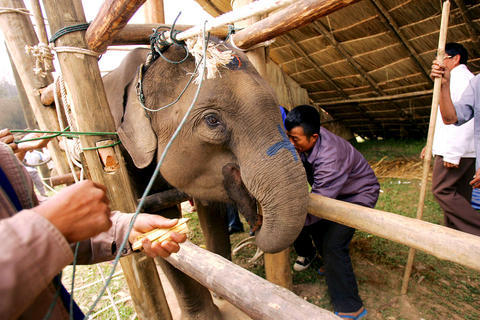Connie Speight has swayed on elephant-back through unforgiving jungle and has adopted nine of the high-maintenance beasts. At 83, the retired American teacher is back in this Southeast Asian country to help save what remains of the once mighty herds.
Once so famous for its herds that it was called Prathet Lane Xane (Land of a Million Elephants), Laos is thought to have only 700 left in the wild.
"Lots of people in Asia tell you how elephants are their proud national heritage," Speight says. "But I tell them, `It was your heritage, and what are you doing to bring it back?' Often precious little."

PHOTO: AP
Elephants in Laos are better off than in most of the 12 other nations that are home to the animals. The country has extensive forest cover and a sparse population. But like elsewhere, it is a race against time. Poachers, dam builders, loggers and farmers are taking a deadly toll on the endangered species.
"The situation will become very dramatic in about 10 years if nothing changes," says Sebastien Duffillot, cofounder of France-based ElefantAsia.
At their current rate of decline, Laos' wild elephants could be extinct within 50 years, he warns.
Domesticated elephants number about 570, a 20 percent drop over the last decade. In all, the World Wide Fund for Nature estimates, as few as 25,000 wild and 15,000 captive Asian elephants may be left. A century ago, Thailand alone harbored some 100,000.
Speight attended a recent elephant festival organized by Duffillot's conservation group "to pay tribute to the emblematic animal of Laos."
One of several elephant conservation efforts under way, the three-day fair featured some 60 elephants. They demonstrated skills in logging, took part in Buddhist ceremonies and walked in stirring processions.
During their heyday, elephants served as the country's trucks, taxis and battle tanks. Laos is communist-ruled today, but it used to be a kingdom that kept its independence by sending elephants as tribute to China and Vietnam.
Organizers said they hoped the annual festival, first held last year, might persuade elephant keepers to use their beasts in the fast-growing tourism business rather than logging.
For many youngsters in the dusty, Mekong River town of Paklay, the morning offering of fruit and snacks to the pachyderms was the first time they had touched an elephant's trunk.
Speight hopes that others in Laos will get the chance as Mae Dok, one of nine jumbos she supports in Southeast Asia, travels the countryside as an ``ambassador elephant'' delivering books to schoolchildren.
A female with a sunny disposition whose name translates as "Mrs. Flower," Mae Dok was rescued from a lifetime of logging labor and may be pregnant -- something which sends Speight into rapture, given the dramatically declining numbers of breeding age females. ElefantAsia estimates that in 15 years there will only be 46 domesticated breeding cows under 20.
Speight, who taught natural history in Santa Barbara, California, has bought land for an elephant sanctuary in northern Thailand and radio collars to monitor calves released into the wild in Sri Lanka.
"If Laos could become a model for what a very poor country can do, that would wave a flag in surrounding countries, some of which are useless," she says.

Kehinde Sanni spends his days smoothing out dents and repainting scratched bumpers in a modest autobody shop in Lagos. He has never left Nigeria, yet he speaks glowingly of Burkina Faso military leader Ibrahim Traore. “Nigeria needs someone like Ibrahim Traore of Burkina Faso. He is doing well for his country,” Sanni said. His admiration is shaped by a steady stream of viral videos, memes and social media posts — many misleading or outright false — portraying Traore as a fearless reformer who defied Western powers and reclaimed his country’s dignity. The Burkinabe strongman swept into power following a coup in September 2022

‘FRAGMENTING’: British politics have for a long time been dominated by the Labor Party and the Tories, but polls suggest that Reform now poses a significant challenge Hard-right upstarts Reform UK snatched a parliamentary seat from British Prime Minister Keir Starmer’s Labor Party yesterday in local elections that dealt a blow to the UK’s two establishment parties. Reform, led by anti-immigrant firebrand Nigel Farage, won the by-election in Runcorn and Helsby in northwest England by just six votes, as it picked up gains in other localities, including one mayoralty. The group’s strong showing continues momentum it built up at last year’s general election and appears to confirm a trend that the UK is entering an era of multi-party politics. “For the movement, for the party it’s a very, very big

ENTERTAINMENT: Rio officials have a history of organizing massive concerts on Copacabana Beach, with Madonna’s show drawing about 1.6 million fans last year Lady Gaga on Saturday night gave a free concert in front of 2 million fans who poured onto Copacabana Beach in Rio de Janeiro for the biggest show of her career. “Tonight, we’re making history... Thank you for making history with me,” Lady Gaga told a screaming crowd. The Mother Monster, as she is known, started the show at about 10:10pm local time with her 2011 song Bloody Mary. Cries of joy rose from the tightly packed fans who sang and danced shoulder-to-shoulder on the vast stretch of sand. Concert organizers said 2.1 million people attended the show. Lady Gaga

SUPPORT: The Australian prime minister promised to back Kyiv against Russia’s invasion, saying: ‘That’s my government’s position. It was yesterday. It still is’ Left-leaning Australian Prime Minister Anthony Albanese yesterday basked in his landslide election win, promising a “disciplined, orderly” government to confront cost-of-living pain and tariff turmoil. People clapped as the 62-year-old and his fiancee, Jodie Haydon, who visited his old inner Sydney haunt, Cafe Italia, surrounded by a crowd of jostling photographers and journalists. Albanese’s Labor Party is on course to win at least 83 seats in the 150-member parliament, partial results showed. Opposition leader Peter Dutton’s conservative Liberal-National coalition had just 38 seats, and other parties 12. Another 17 seats were still in doubt. “We will be a disciplined, orderly